Water Quality Project Resources:

The U.S. Environmental Protection Agency has estimated that 59 million pounds of active pesticide ingredients are used on homes and gardens each year. This includes 28 million pounds of herbicides, 14 million pounds of insecticides, and 17 million pounds of other types of pesticides.
Our coastlines are currently home to 40% of the U.S. population. We live, work, and recreate along the coasts. Clean water is critical for life itself. We depend on clean, clear water for drinking, bathing, swimming, fishing, and enjoying the beauty of the shoreline. Tourism and recreation, such as fishing, boating, hunting, and birding, are important economic drivers. Billions of dollars and millions of jobs depend on clean water and healthy coastlines.
The seafood industry is an important part of our economy, valued at over $5 billion in 2014. Fish and shellfish need clean water to hatch, feed, and spawn. Birds, marine mammals, and other wildlife also depend on clean water.
The average American household uses 320 gallons of water per day. About 30% of that amount is used for watering lawns and gardens. Half of landscape water is wasted due to evaporation, wind, or runoff.
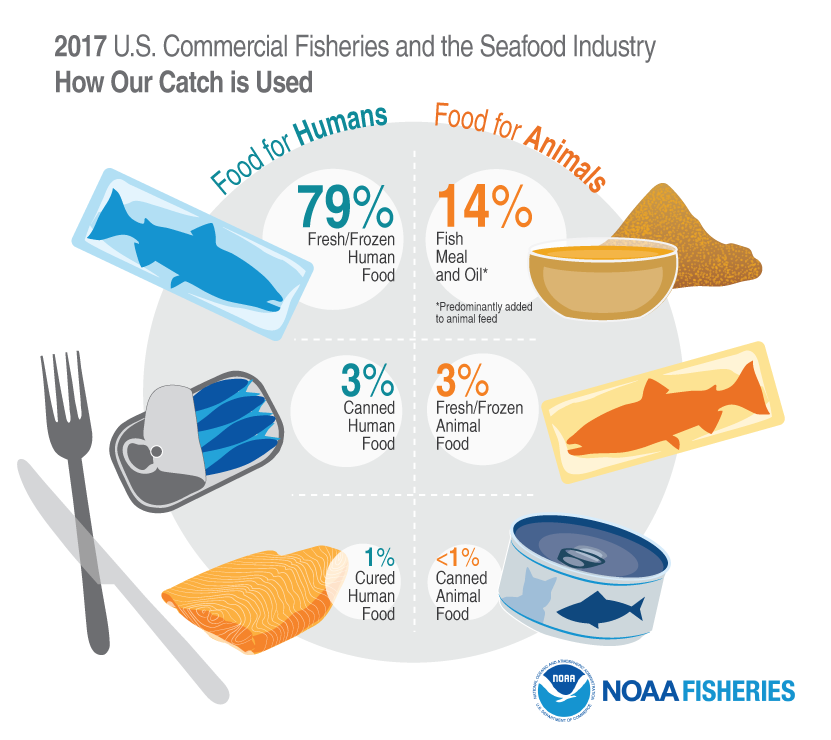
Source: NOAA Fisheries – fisheries.noaa.gov
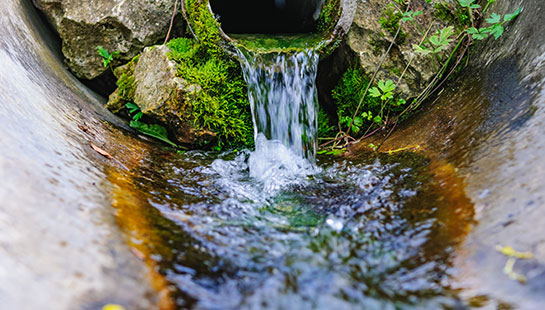
Stormwater runoff
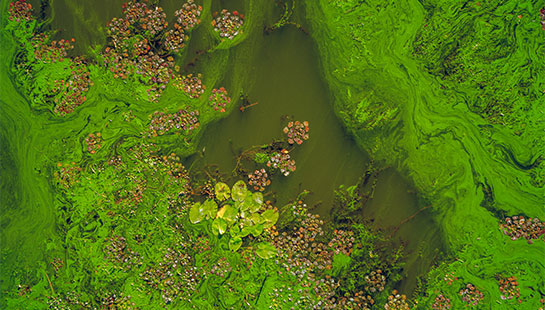
Algal bloom – In many coastal regions, surface water runoff is now the major source of water pollution and increased algae blooms.
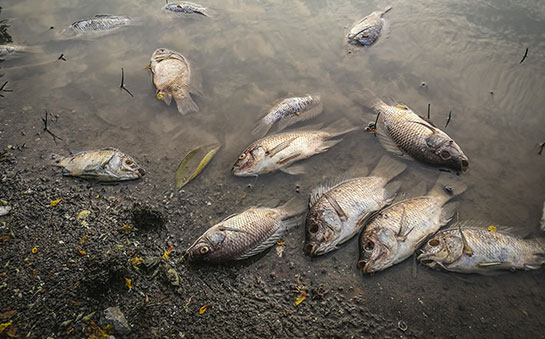
Fish kills can be a result of poor water quality and high pollution levels.
There is a long trend of higher population growth on the coasts. Coastal counties have grown an average of 5.6% since 2010, while inland counties grew just 4% (US Census Bureau).
Population growth leads to development: more houses, roads, shopping areas, and commercial and industrial facilities. All of these hard (impervious) surfaces increase surface water runoff. When it rains, runoff polluted with sediment, nutrients, pesticides, bacteria, heavy metals, and petroleum by-products flows into our waters.
In many U.S. coastal regions, surface water runoff is now the major source of water pollution. Pollution from sources such as industry and sewage treatment plants has decreased since passage of the 1972 Clean Water Act. However, surface water runoff comes from many diffuse sources, making it difficult to control.
Nutrient pollution, from excess nitrogen and phosphorus, is one of the most widespread and costly water quality problems. About 2/3 of our coastal areas and more than 1/3 of our estuaries are impaired by nutrient pollution.


Reducing pollution and restoring clean water is important for the health of people, fish, and wildlife. Restoration of natural features, such as healthy wetlands and shorelines, helps to reduce runoff and filter polluted water.
You could green your property to create a positive environmental impact. Easy ways you and your neighbors could make your community greener include: reduce polluted runoff by installing a rain garden, plant trees and native plants, or take other steps to improve quality of life for you and for local wildlife.
Restoring degraded salt marshes and wetlands improve water quality. Salt marshes are coastal wetlands that are flooded and drained by salt water brought in by the tides. These important habitats clean water by filtering sediments, nutrients, heavy metals, and other toxins from upland runoff. One study showed that in-stream wetlands reduced nitrate from 7 parts per million(ppm) to less than 1 ppm.
Try natural yard care practices to maintain your lawn and garden. By working with nature in your yard, you can have a great looking landscape that is easier to care for and healthier for people, pets, wildlife, and your local environment.
Trees, more than any other plant, limit soil erosion. Their extensive root systems hold soil in place so it is not washed away by rain or flowing water. Tree roots help stabilize stream banks, protecting habitat for fish and wildlife. Trees and other plantings along stream banks are critical for endangered fish and wildlife.
Trees also sequester and store carbon dioxide, which helps reduce climate change. They bring multiple benefits to communities, such as greater beauty, more vibrant shopping districts, and reduced crime. Trees can reduce residential heating costs in winter and air conditioning costs in summer.
Some cities and counties have programs in place to give away or plant trees in order to increase the urban forest canopy. Ask your local government what programs are available in your community.
VIDEO: 10 Steps on How to Plant a Tree Properly
Community gardens not only beautify neighborhoods and enable people to grow nutritious food, they also enhance community, increase green space in urban areas, and conserve resources. The American Community Gardening Association has resources on starting a community garden.
Your local government or university extension service may support community gardens. Seattle’s P-Patch Program, Los Angeles Community Garden Council, and the University of Maryland Extension’s Community Gardens are just three of many examples.
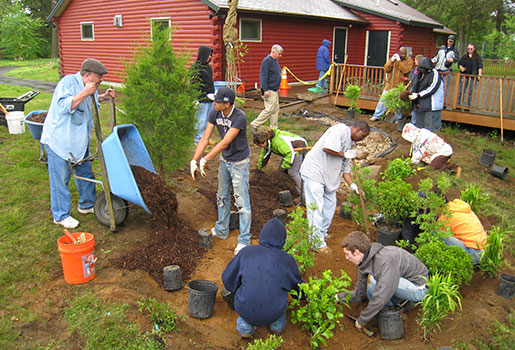
A local community planting a rain garden
In recent years some schools have added gardens. Students grow food and other plants, learn about the environment, and add green space to the school yard. Perhaps you could help your local school or PTA with a similar project.
Rain gardens capture and filter stormwater and slow the rate of runoff. Each time it rains, water runs off hard surfaces, such as roofs or driveways, collecting pollutants such as fertilizer, chemicals, oil, dirt particles, and bacteria along the way. This water enters storm drains untreated and can flow directly to nearby streams and ponds.
In many U.S. coastal regions, surface water runoff is now the major source of water pollution and increased algae blooms. Research found that microbes in rain gardens biodegraded 90% of petroleum pollutants in two to eight days. Multiple studies found that soil and mulch in rain gardens adsorb and hold heavy metals. A planted swale reduced surface runoff by 89% and pollutants by 95% in one study.
One way to reduce runoff from your property and help filter out pollutants in runoff is to plant a rain garden. This is a shallow depression in the landscape that collects rain water from a roof, patio, or driveway, and allows it to soak into the ground. Rain gardens are planted with grasses, shrubs, and flowering perennials.
Rain gardens can also recharge groundwater, reduce garden maintenance, attract beneficial insects, and create habitat for birds and butterflies.
Many cities across the country offer rebates for rain garden design and construction. Consider joining with your neighbors to plant rain gardens. The accumulated benefits to water quality and habitat will be much greater than just one rain garden.
Checkout this app to help you design, install, and maintain a rain garden.
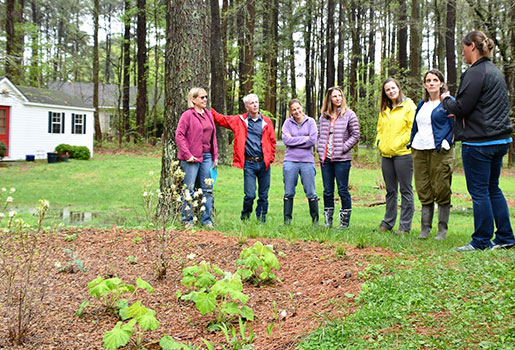
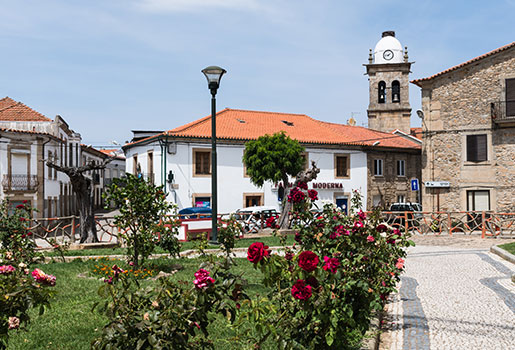
Community and rain gardens are a great way to reduce impermeable surfaces and add natural beauty.
As coastal areas grow and develop, green spaces are replaced by houses, roads, shopping areas, and commercial and industrial facilities. All of these hard (impervious) surfaces increase urban runoff. When it rains, runoff polluted with sediment, nutrients, pesticides, bacteria, heavy metals, and petroleum by-products flows into our waters.
Trees reduce runoff by breaking rainfall, and they help prevent stormwater from carrying pollutants into nearby waters. When trees are combined with other natural landscaping, as much as 65% of storm runoff can be reduced in residential areas.
Permeable pavement is one approach to reducing the amount of runoff. It allows rainwater to pass through it into the ground below. Studies show that multiple types of permeable (or pervious) pavement substantially reduce the volume of runoff. They also reduce pollutants, including heavy metals, motor oil, sediment, and some nutrients.
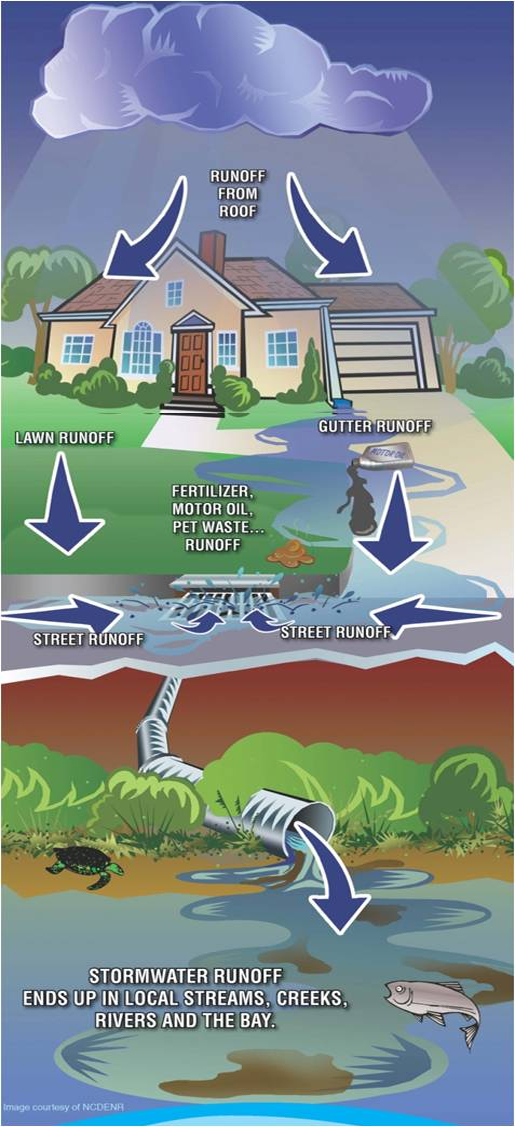
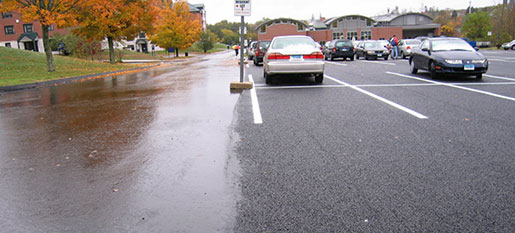
Permeable pavement allows rainwater to pass through it into the ground below, reducing the amount of runoff.
We can all take actions to help reduce runoff and to improve and protect water quality.
We need your help to improve the Toolkit by completing our easy, 3-minute survey. Your insight is valuable to us.